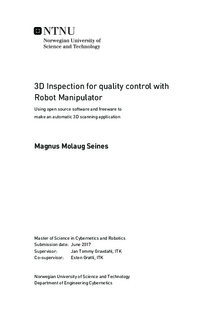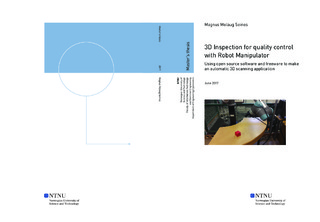| dc.description.abstract | As modern industry is automated the need for robots performing complex tasks increases. To achieve fully automated production both making the product and inspecting it for quality assurance needs to be automated. Robotic manufacturing processes have been around for a long time and has greatly increased the efficiency of modern industry. In this thesis existing framework for automatic 3D inspection is examined, and an attempt at making a working 3D inspection implementation is made.
The work is centered around offline inspection planning, using a model reference to generate a path for fully inspecting a 3D object with a sensor attached to a robot arm.
Continuing previous work, the inspection planning algorithm proposed by A. Bircher et. al. 2015 is adapted further in an attempt to make it optimal for planning inspection of small to medium sized objects with an industrial robot arm.
The modification of the structural inspection planning algorithm is evaluated compared against the algorithm without modification by comparing resulting path length and algorithm convergence. The augmentations appear to increase the performance of the inspection planning algorithm when planning in 5 dimensions.
To simulate inspection with a UR5 robot, a camera mount for the Intel RealSense SR300 sensor is 3D printed and attached to the wrist link. Sensor position relative to the wrist joint is measured and used to make a custom URDF and SRDF for the UR5 such that collision between the sensor and other joints can be prevented and sensor position can be controlled accurately.
The resulting inspection paths are simulated in Gazebo with two different approaches to motion planning. To further test in detail how effective individual improvements to the algorithm have been with regards to inspection path quality the algorithm is separated into different iterative versions, where the path generated by each version with otherwise identical parameters are simulated, and the resulting motion of the robot is compared with the intended path.
The augmentations of the inspection planner improve robot behavior. However, logging sensor state reveals the sensor has incorrect orientation when reaching the waypoints. The Cartesian motion planner fails to produce a full trajectory for most paths. The inverse kinematics based point to point planner leads to undesirable behavior such as arcing motions between waypoints and goal overshoot.
To test basic functionality for point cloud acquisition some of the generated paths are run on the real robot, while both the robot state and 3D sensor output is being logged.
The SR300 performed poorly, possibly due to poor lighting conditions.
It is concluded that the inspection planner should be rewritten to incorporate trajectory planning in joint space. The inspection planner appears to perform well but needs additional measures for adapting the path for inspection with manipulators. | |

